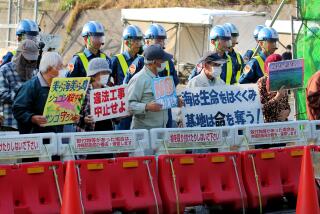U.S. May Deploy Missiles in Japan
- Share via
TOKYO — The United States plans to deploy advanced Patriot missiles at its facilities in southern Japan by the end of the year, a Japanese newspaper reported today.
The U.S. government notified Japan this month that it would deploy the surface-to-surface Patriot Advanced Capability-3 missiles in Japan for the first time, amid signs that North Korea plans to test-fire a ballistic missile, Yomiuri Shimbun newspaper reported.
For the record:
12:00 a.m. June 28, 2006 For The Record
Los Angeles Times Wednesday June 28, 2006 Home Edition Main News Part A Page 2 National Desk 1 inches; 36 words Type of Material: Correction
Missile deployment: An article in Monday’s Section A described the Patriot Advanced Capability-3 missile that the United States plans to deploy in Japan as a surface-to-surface weapon. It is a surface-to-air weapon designed for missile interception.
The U.S. military would deploy three or four of the missiles on the southern island of Okinawa, where it also plans to deploy an additional 500 to 600 troops, the newspaper said, quoting unidentified sources.
Tokyo is expected to accept the plan, which was proposed by U.S. officials during a June 17 meeting in Hawaii.
Growing concerns about North Korea’s suspected moves toward test-firing a long-range ballistic missile also have prompted the United States to move up its planned test of a missile-detecting radar in northern Japan, Kyodo News agency reported. Testing of the radar could start as early as today, the news agency said.
Japanese Defense Agency officials were not immediately available for comment.
The test run of the high-resolution radar capable of detecting missiles was initially scheduled to begin later in the summer.
The so-called X-Band radar had been transferred to the Japanese Air Self-Defense Force’s Shariki base in Tsugaru, about 360 miles north of Tokyo, the Defense Agency said.
More to Read
Sign up for Essential California
The most important California stories and recommendations in your inbox every morning.
You may occasionally receive promotional content from the Los Angeles Times.










